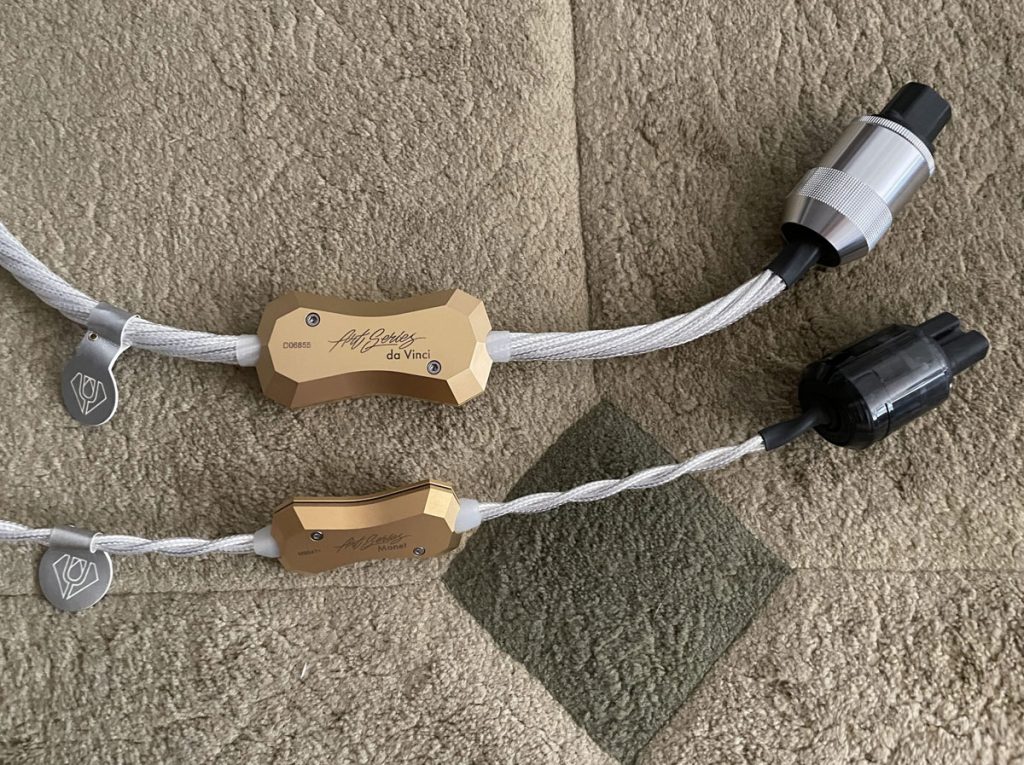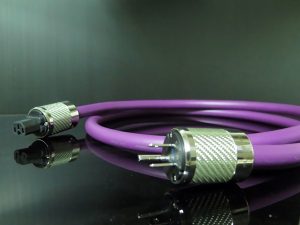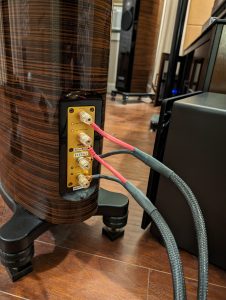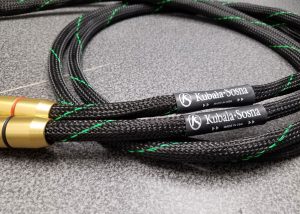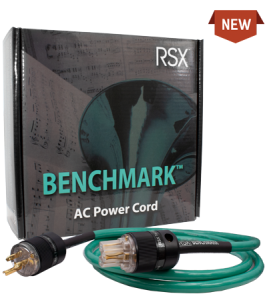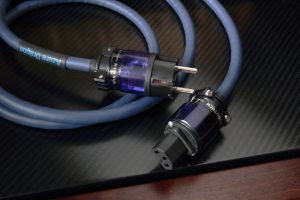For many years I scoured the fleas and thrifts, scarfing up cheap classical and, to a lesser extent, jazz LPs. The getting was good and the leaning towers behind my speakers mushroomed, inevitably forcing the zero sum rule of collecting: if something comes in, something else goes out. It only works if you're rigorous about it and don't let your guard down. Still, there may be as many as 25% of the keepers that never see playtime. Why do I retain them? Because they were on a published list or considered important by a music critic.
Many of the unplayed involve large groups whose performance is marred by articulation issues. Some have contrapuntal scoring, where no single instrument carries the melody and it bounces around from one instrument to the other. My attention follows likewise, trying to make sense of it, but blurry entrances or exits obscure the beat and dull the pulse.
Could the audio system play a role in this? It is only a carrier passing the signal along, right? In retrospect, that is naive.
Aaron Copland composed a body of immensely popular symphonic scores in the early twentieth century—and was critically lambasted. He took note and shifted gears, attempting to give the critics what they had asked for. Around mid-century, he began to publish twelve-tone serialist compositions. The new work went out of its way to challenge (or alienate) the listener and was poorly received by critics and public alike. These scores are rarely programmed nowadays.
How Well Does the System Communicate?
Connotations, composed in 1962, is typical of this late style and it's included on Copland: Symphonies, Vol.4 (CHAN 5222 SACD), with John Wilson leading the BBC Philharmonic Orchestra. Featuring the brass instruments, with trumpets and trombones on the right, French horns left, woodwinds in the middle, all playing loud and dissonantly in the upper register, it quickly congeals into a sonic miasma. I could never get my ears around Connotations and began to view it as a challenge, periodically returning for another go.
So things stood when a box with Da Vinci Power Cables from Crystal Cable came in the post. After burn-in, they went onto my CH Precision D1 transport, C1 DAC, and T1 clock. Connotations went on the transport again, and spread out before me—same soundstage extension, similar tonal balance. If you own good quality power cords and have balanced sound, the DVs will not shake up the firmament by boosting bass or increasing slam. What they do is less obvious. First, the sonic miasma fractured, as the instruments spread out and took up positions around the stage with enough separation so they could be discerned independently. Second, the transients were landing with better time alignment. Taken together, this allowed me to peek inside and discern a logic not apparent before. What had been a series of ill-defined and unconnected notes now had a structure. It still strikes me as a bunch of off-kilter, odd compositional choices; I just can't see the appeal. But, at a minimum, I had a clear-eyed view of what went down in the studio. The DV power cables had this clarifying effect on everything I played.
Beautiful Transitions
"Wow, that was a beautiful transition!" We found ourselves admiring anew well-played recordings. The evidence appeared in the form of more polished hand-offs, as when the soloist and orchestra engage in call and response: one instrument has the melody, one is supporting, and the exact moment when the roles reverse. Or when one section subtly shifts the key and introduces a new melody. It wasn't as if the DV power cables resolved more deeply—detail retrieval was comparable to before. The change was in the quality of the details; they conveyed more musical meaning.
What's going on here? How can a power cable affect that kind of change? An old-timey HiFi attribute we used to talk about a lot came to mind. PRaT refers to the ability of some products to lay down an infectious rhythmic pulse. Products with good Pace Rhythm and Timing sport crisp, fast-moving transients and convey the beat of the music.
Transient quality is an integral part of PRaT. When the transient lacks coherency, some frequencies arrive early or lag behind. In turn, the irregular wavefront degrades your perception of the performance—the human ear is keenly sensitive to the slightest unsynchronized entrance—making the musicians appear to have less skill. Gremlins that can degrade PRaT lurk in every corner of an audio system, from multi-driver loudspeakers with coherency issues, to jitter in the digital sphere, to cables with timing problems.
The DV PCs stimulated vigorous toe-tapping, head-bopping, and nailed the big beat. And they improved what I'll call the small 'T,' or the inner beats, the transients continually unfolding throughout the score. The DV PCs expertise at preserving time domain relationships was unparalleled.
Low Frequency Discrimination
Going about my business one afternoon, I put on M.O.M., a recent jazz trio acquisition (LABORIE Jazz, LJ59 CD). Looking at the funky cover art, you would expect it to be a free jazz excursion. Don't let that throw you. While there is some truth to the assumption, these guys—Louis Moutin, Jowee Omicil, and Francois Moutin—are rooted in the classic tradition. All are studio musicians who met on the set of the Netflix series The Eddy. (You can stream it on Qobuz. The CD might be hard to find.)
My attention latched onto unusually deep notes coming from the double bass that seemed lower in pitch than at last listen. I know that's unlikely; isn't the note's fundamental fixed at the time of recording? Then it must be harmonics below the fundamental were more active. On these occasions, the DV bass output was deep and generous.
The interplay between the upright bass and bass drum displayed resolution and vitality not present before. A mallet strike on the skin of the bass drum emitted a very full-bodied transient of indeterminate pitch somewhere below the lowest notes of the upright bass. The fast attack and very deep tone of the bass drum on this recording lands like a soft punch to the chest, you feel it somatically, complementing what comes through your ears. Its transient was immediately followed by the sound of an air chamber being pressurized. Meanwhile, the plucked string transient of the double bass had an entirely different quality. It melds quickly into the note's sustain, as the wooden body of the instrument begins resonating, and then resolves into a very complex, changeable, decay. The DV power cable's low frequency acuity was rather extraordinary.
On the other hand, if the source didn't have much in the way of deep tones and resonances, the DV won't manufacture them. Crystal Cable is proud of their product's neutrality, and the DV bass sounds quite natural, perhaps less warm than my reference PCs, but with greater density and firmness.
Usually, wires with a lot of energy down below tend to short the frequencies above. If there's only so much room, growing the bass squeezes the mids and treble, which become proportionately less audible. That didn't happen with the DV PCs: the strong bass did not trickle upward or mask those frequencies.
Soundstage Presentation
All of these qualities are manifest in the DV's soundstage. Spatial depth expands front to back, giving a sense that the stage isn't flat, and the large sound objects stand distinct. Nothing on the stage is sharp or abrasive; the instruments speak in composed voices and ear-feel is smooth and luxurious. This is not a showy, extrovert cable. (The same can be said of every wire in the Art Series, increasingly as you go up the line.) When the stage is organized like this it seems less busy, there are less distractions. It may even give the impression that it's been simplified.
Infinite Crystal Silver (iCS)
Crystal Cable and its sister company, Siltech, have long been famous for their silver-gold alloy. Pure silver conductors are drawn, then gold is sparingly applied to fill in minute fissures and crevices that naturally occur in the silver. In a recent development, they discovered a process that eliminates the micro-cracks in the silver—hence, there is no longer a need for the gold fill. The new conductor material named Infinite Crystal Silver (or iCS) is 100% silver. It is claimed to measurably increase conductivity and reduce micro distortions, while preserving pitch and pattern. I suspect iCS plays a big role in the DVs communication skills.
There are three levels and price points in Crystal's flagship Art Series. All use iCS conductors. The main difference is the number of conductor runs: two in the Monet, four in the Van Gogh, and six in the Da Vinci. (This applies to all analog cables, not network and other digital leads.) A variety of wire geometries are used for different types of cables. For example, the Da Vinci XLR interconnect construction is two coax plus four ground wires. The DV speaker and power cables use six triax. In addition, different shielding materials are used. The DV PC uniquely uses a combination of silver-plated copper and iCS for the shield.
The use of iCS conductors throughout the Art Series imparts a commonality to the sound, while the variances in shielding materials and geometry account for differences.
Cosmetics, Aesthetics and Parts Quality
The DV Power Cable resembles other Art Series cables, although not as thin, lightweight, or flexible. They are thick as a light-gauge rope, about twice the girth of the DV Interconnect. The Monet power cables, in comparison, are like strings; that said, the DV PCs are still on the lighter side of most top-drawer PCs.
DV on top, Monet PC on bottom
Art Series cables have no outer covering, leaving the braided conductor cores visible. As shown in the photo, the Da Vinci power cable has a much heavier assembly of conductors than a Monet PC (and Van Gogh Speaker Cable). Still, if you gently shape the DV into a curve, or even a full circle, it will retain the bend.
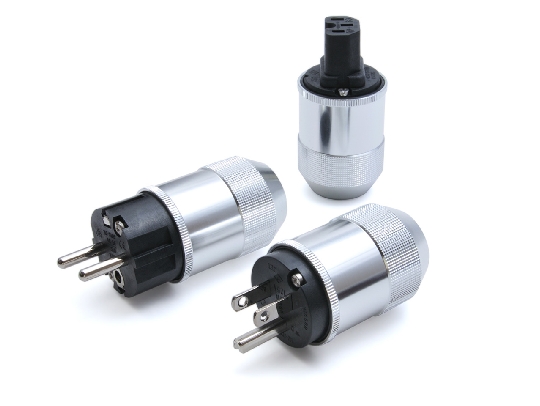
Thin, elegant, top-drawer fabrication, expensive—that describes the Art Series cables. The color scheme is silver with gold accents in a coordinated visual palette like the colors of a painting. Except for the 23k gold-plated branding barrel with the Art Series logo, there is no bling—just the parts needed to get the job done. The build is outstanding, with parts carefully chosen from among the highest quality available. If you have overbuilt power cables and replace them with the Da Vinci, the room will look like you hired an interior decorator.

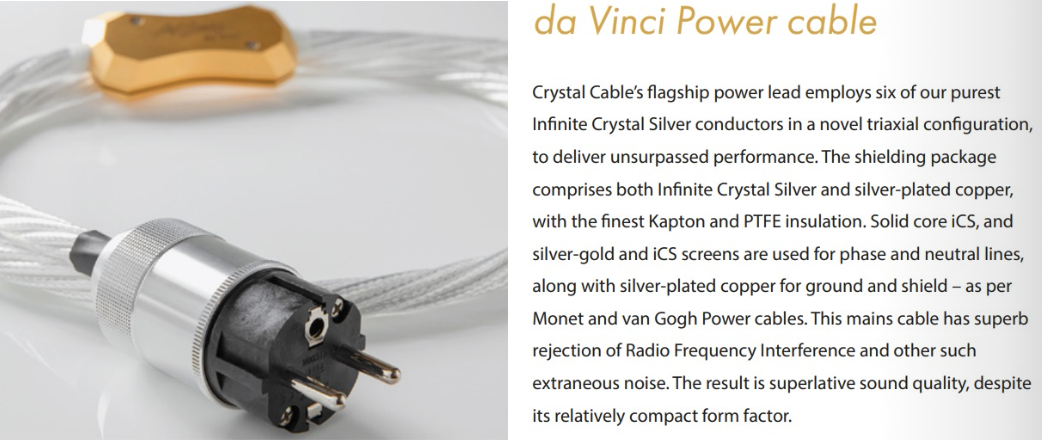
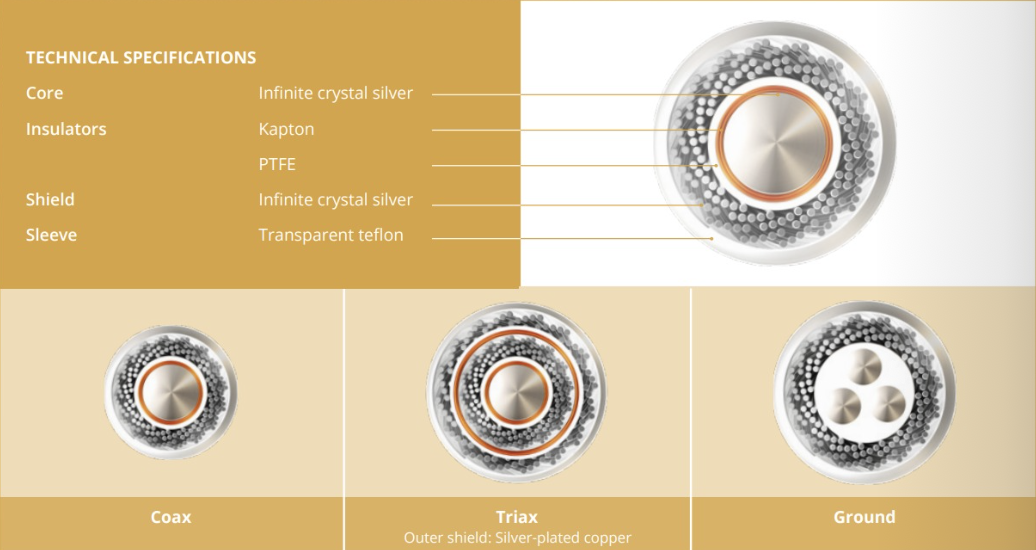
Installation and Burn-in
Although the cables are burned-in at the factory, Crystal advises an additional minimum of 100 hours with music after installation. I gave them four days on the Cable Cooker. (Every cable benefits from time on this burn-in device; the DV PCs were no exception.) They sounded good at this point. After another day and a half plugged into their components, we had arrived.
I found placement makes a difference and made every attempt to route them in a way that reduced interactions, especially with other power cords. At this level of play, cable lifts are also important, so I experimented with several third-party ones. The Art Series wires prefer natural materials, such as cardboard or wood. (I wonder why that is?) A cardboard shipping tube cut down to size was best; alternately, try a stack of walnut wood blocks. These homemade solutions have no aesthetic cachet, unfortunately.
Conclusion
What's the most important function of a home audio system? It's hard to imagine anything that beats engagement with the musicians, but I allow your goals may vary. Lots of audiophiles chase after resolution, defined as the indiscriminate piling on of detail. Simply put, more is better. In musical terms, however, resolution refers to the conclusion of a musical thought, usually when you come to rest on the tonic chord. There's a satisfying sense of closure. This applies not just to the final bars—musical ideas are continually expounded and resolved throughout the composition.
When I listen to Daniil Trifonov, Víkingur Ólafsson, or Rudolf Buchbinder, the way they handle certain passages and develop themes inside each movement conveys an individual interpretation. Like the chapters of a novel, their reading of the score builds to an over-arcing conclusion. It becomes a journey. On the other hand, the keyboard virtuosity of artists like Marc-André Hamelin or Leif Ove Andsnes is a marvel behold, but they don't communicate a storyline; hence, there's no journey.
The Da Vinci Power Cables from Crystal Cable give you the best chance of hearing these stories. The design goals prioritize fidelity to the source, especially regarding the time domain, where these cables preserve transient alignment, thus boosting the quality and musical content of the details. The proof lay in the intensity of listener engagement. Mind you, this attribute has nothing to do with adding coloration or euphony. On the contrary, the DV are among the most neutral, and Crystal Cable has the test bench measurements to prove it.
I didn't rundown the audiophile report card at length other than the bass. Nor did I linger on the refined beauty of their sonic palette. Rest assured, the DV perform as well as the very best I've heard and set new benchmarks for some parameters. But their communication skills are so exceptional that it became my focus and detailed explanation was warranted.
Cable advances of this kind don't come around every day. The Da Vinci Power Cables from Crystal Cable will take up residence in my Desert Island inventory right alongside the Da Vinci XLR Interconnects and Van Gogh Speaker Wire. The slot has now been filled.
Da Vinci Power Cable
Retail: $15,000/1m
Crystal Cable








